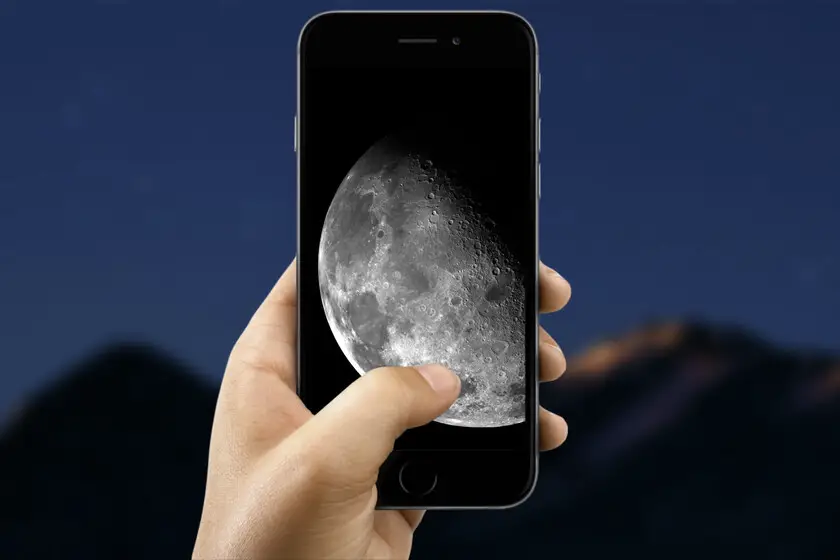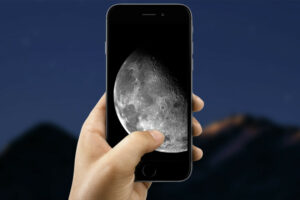
With its ethereal beauty and mysterious allure, the moon has always been an intriguing subject for photographers. Capturing stunning moon images may be a gratifying experience, allowing you to record moments in time while highlighting the grandeur of our cosmic companion. With smartphone camera technology developments such as the iPhone 14, 13, 12, and 11, you now have a formidable weapon at your disposal for moon photography. In this tutorial, we’ll walk you through the steps of taking stunning moon photos with your iPhone.
Before we get into the details, let’s take a moment to recognize the importance of moon photography. Throughout history, the moon has served as an inspiration to numerous artists, poets, and visionaries. You can immortalize the moon’s beauty, produce awe-inspiring photographs, and elicit emotions in your viewers by photographing it. You may easily explore this fascinating genre of photography with the simplicity and accessibility of iPhone cameras.

Best Way to Snap the Moon
Before you embark on your moon photography journey, it’s essential to grasp the basics of this genre.. Because of the peculiar lighting conditions and the moon’s distance, moon photography necessitates special considerations. Because the moon is essentially a reflecting object, catching its subtleties can be difficult. However, with the right techniques and equipment, you can overcome these challenges and create stunning images.
Getting Ready to Photograph the Moon
Make the essential preparations before taking beautiful moon pictures with your iPhone. Begin by ensuring you have the necessary tools and accessories. While iPhones have powerful built-in cameras, certain additional tools can help you get the most out of your moon photos. Tripods and smartphone mounts provide stability, which reduces the likelihood of shaky photos. You may also use external lenses to magnify the moon and bring it closer to the camera.
Once you’ve assembled your equipment, it’s time to fine-tune your camera settings. Manual adjustments are generally recommended for moon photography to give you more control over the exposure and focus. Experiment with various settings to find the best combination of brightness and detail. Additionally, turning off the flash is crucial as it can wash out the moon’s delicate features.
Getting Ready to Photograph the Moon
Make the essential preparations before taking beautiful moon pictures with your iPhone. Begin by ensuring you have the necessary tools and accessories. While iPhones have powerful built-in cameras, certain additional tools can help you get the most out of your moon photos. Tripods and smartphone mounts provide stability, which reduces the likelihood of shaky photos. You may also use external lenses to magnify the moon and bring it closer to the camera.
Once you’ve assembled your equipment, it’s time to fine-tune your camera settings. Manual adjustments are recommended for moon photography to give you more control over the exposure and focus. Experiment with various settings to find the best combination of brightness and detail. Additionally, turning off the flash is crucial as it can wash out the moon’s delicate features.
Shooting Techniques for Moon Photography
When it comes to taking moon images with your iPhone, you may get great results by using the default camera app. The native software includes a variety of shooting modes and features that can be useful for moon photography. Switch to manual mode or use a specialized camera app that permits manual changes to gain more control over your images.
One important thing to remember is to manually change the exposure and focus. You can lock the focus and exposure settings by touching on the screen and holding your finger on the moon. This keeps the moon crisp and correctly exposed in your shots.
Use a telephoto lens on an iPhone model with a telephoto lens, such as the iPhone 12 Pro Max or the iPhone 11 Pro, to snap closer photos of the moon. The telephoto lens allows you to zoom in and magnify the intricacies of the moon, resulting in stunning photos.
Tips for Composition and Framing
While photographing the moon alone is breathtaking, including items in the foreground can provide depth and context to your images. Play around with different compositions by using silhouettes of trees, buildings, or other fascinating items. The juxtaposition of the moon with the foreground components provides a visually pleasing image that adds to the overall effect.
Furthermore, don’t be scared to experiment with other angles and views. Move around, alter your perspective, and try out different framing possibilities. This allows you to build unique and captivating compositions that stand out from the standard moon pictures.
Editing Moon Pictures on iPhone
After you’ve taken your moon photos, use the editing capabilities on your iPhone to improve them. The Photos app includes a variety of editing features for fine-tuning your images and bringing them to their full potential.
Begin by improving the moon’s details and clarity. To increase the clarity and crispness of the moon’s surface, use the sharpening tool in the editing menu. To achieve a well-balanced image, adjust the exposure and contrast. Be mindful not to overdo it, as preserving the moon’s natural look is crucial for an authentic result.
If you’re feeling artistic, you can add filters to your moon photos to add a touch of flair. Experiment with various filters and modify their intensity to create a distinct atmosphere and mood in your images.
Showcasing Your Moon Pictures
It’s time to share your moon photos with the world after you’ve edited and finished them. Social media networks like Instagram and Facebook are great places to showcase your work and connect with other photographers. Create a caption that matches your image and engages your viewers. Include relevant hashtags to boost the visibility of your moon photos.
You can also try printing and framing your moon images if you prefer the tactile feel of real printouts. Display them in your house or even take part in local art shows to share your artistic ideas with a larger audience.
Common Challenges and Troubleshooting
Moon photography is not without its difficulties. Dealing with low-light situations is a regular problem. Because the moon is frequently photographed in low-light conditions, getting adequate exposure without introducing noise can be tricky. Experiment with various exposure settings and editing tools to balance the brightness and keep details in your moon photos.
Another difficulty you may face is precisely concentrating on the moon. The camera may struggle to focus on a distant object, such as the moon. To overcome this, manually adjust the focus in your camera app by touching and holding on the moon. This enables you to focus and take sharp photographs.
Conclusion
Photographing the moon with your iPhone 14, 13, 12, or 11 is an interesting and gratifying task. You may take magnificent moon images that display the majesty of the night sky by learning the techniques, making the preparations, and using the settings. Remember to experiment with different compositions and let your imagination run wild. With experience and patience, you’ll be able to create moon images that will endure a lifetime.





Leave a Reply